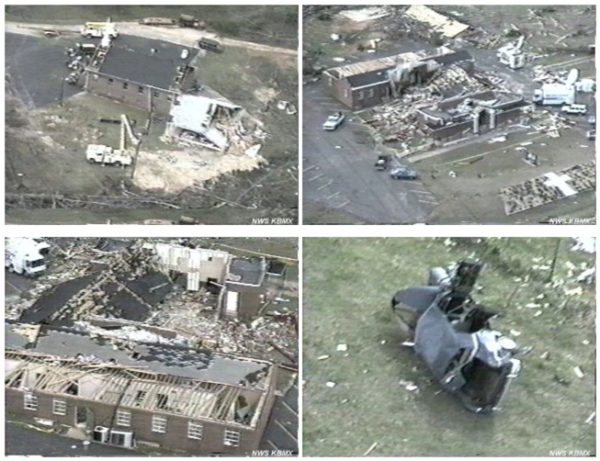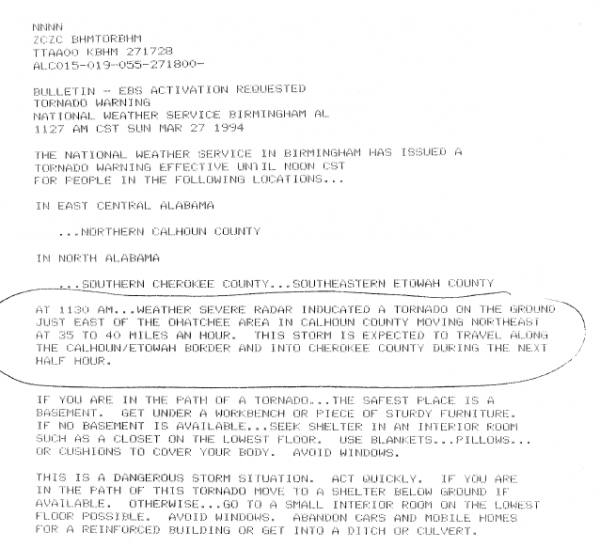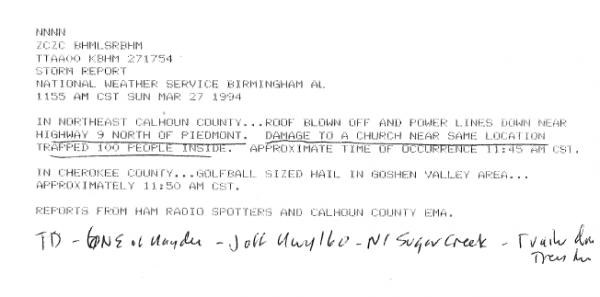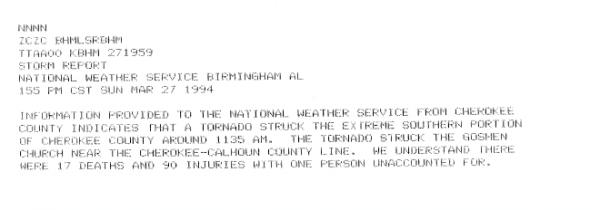March 27, 1994: The Goshen United Methodist Church Tornado

Images from the NWS Birmingham
March 27, 1994 was Palm Sunday. I was a meteorologist at Channel 42 in Birmingham. The Chief Meteorologist was away that day and I was scheduled to work. I had been eying the weather for that Sunday for several days. The event seemed to have a lot of the earmarks for a significant severe weather outbreak. The National Severe Storms Forecast Center had much of North and Central Alabama in a Moderate Risk outlook for severe weather. Temperatures were in the 70s with dewpoints in the upper 60s at 9 a.m. A tornado watch was issued at 9:30 a.m.
A thunderstorm crossed the Birmingham metro area around 10 a.m. A tornado watch had just been issued, and things were starting to deteriorate. As I watched out the back door of the station, it was clear that the supercell had a wall cloud and it was definitely rotating. I lobbied hard to break in during the local broadcast of the Dawson Memorial Church service, but there was no warning in effect.
I watched on radar as the supercell roared out of northeastern Jefferson County. A tornado warning was issued for St. Clair County at 10:53 a.m. because of that storm. A possible tornado was located near Odenville.
A tornado warning was already in effect for Calhoun and Cherokee Counties. We didn’t have access to Doppler radar information then, but it was evident that this storm was capable of producing a tornado. I went on the air with the tornado warning. Channel 42 only provided warnings for Jefferson, Shelby, Walker, Tuscaloosa, Blount and St. Clair Counties, so when the storm moved into northern Calhoun County near Ohatchee, I became a spectator.

The actual warning from the NWS Birmingham that provided a 12 minute lead time on the tornado.
At 11:27 a.m., a dramatic tornado warning was issued for Cherokee County. My heart sank as a I listened to the amateur radio spotter reports on 146.88 MHz. A tornado had struck a church near Goshen. Looking at my watch, it was nearing 11:45 a.m. That meant that it was a near certainty that the worship service was going on when the tornado struck. Shortly after that, ham operators were asked to stop communicating information about the church. It was obvious that a disaster had occurred.
The Goshen Tornado touched down near Ragland at 10:51 a.m. It struck Ohatchee and then passed near Piedmont before hitting the Goshen United Methodist Church at 11:39 a.m. Twenty people died in the church another ninety were injured. The people in the church never heard the warning.
The lesson to be learned here is that every home, business and church in the range of a NOAA Weatheradio station must a proper severe weather safety plan and a way to get warnings. It is a matter of life and death.
Follow my weather history tweets. I am wxhistorian @ twitter.com
Category: ALL POSTS, Met 101/Weather History

















